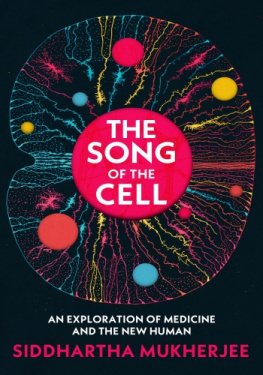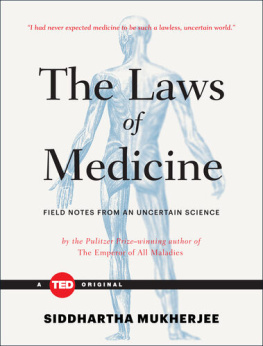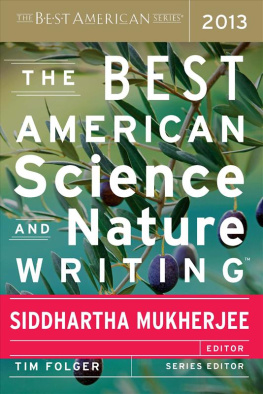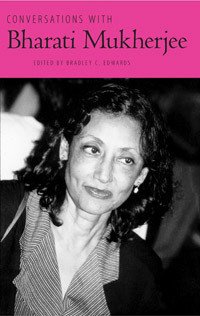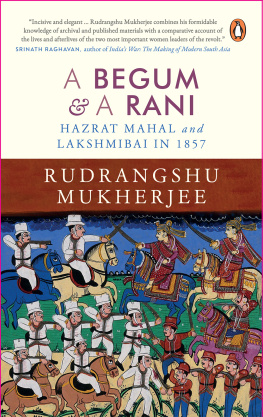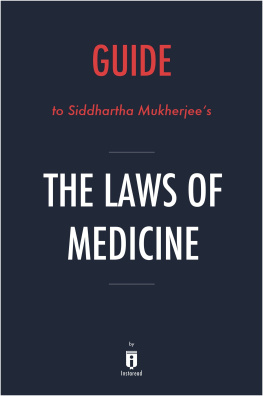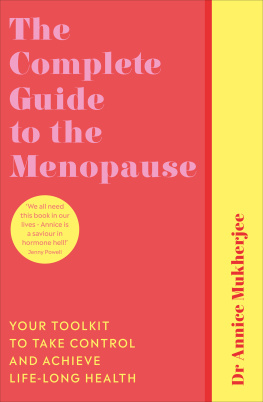Thank you for downloading this TED Books eBook.
Join our mailing list and get updates on new releases, deals, bonus content and other great books from TED Books and Simon & Schuster.
C LICK H ERE T O S IGN U P
or visit us online to sign up at
eBookNews.SimonandSchuster.com
We hope you enjoyed reading this TED Books eBook.
Join our mailing list and get updates on new releases, deals, bonus content and other great books from TED Books and Simon & Schuster.
C LICK H ERE T O S IGN U P
or visit us online to sign up at
eBookNews.SimonandSchuster.com
CONTENTS

Simon & Schuster
1230 Avenue of the Americas
New York, NY 10020
www.SimonandSchuster.com
Copyright 2015 by Siddhartha Mukherjee
This publication contains the opinions and ideas of its author. It is intended to provide helpful and informative material on the subjects addressed in the publication. It is sold with the understanding that the author and publisher are not engaged in rendering medical, health, or any other kind of personal professional services in the book. The reader should consult his or her medical, health or other competent professional before adopting any of the suggestions in this book or drawing inferences from it.
The author and publisher specifically disclaim all responsibility for any liability, loss or risk, personal or otherwise, which is incurred as a consequence, directly or indirectly, of the use and application of any of the contents of this book.
The names and characteristics of some individuals have been changed.
All rights reserved, including the right to reproduce this book or portions thereof in any form whatsoever. For information address Simon & Schuster Subsidiary Rights Department, 1230 Avenue of the Americas, New York, NY 10020.
TED, the TED logo, and TED Books are trademarks of TED Conferences, LLC.
First TED Books hardcover edition October 2015
TED BOOKS and colophon are registered trademarks of TED Conferences, LLC.
SIMON & SCHUSTER and colophon are registered trademarks of Simon & Schuster, Inc.
For information about special discounts for bulk purchases, please contact Simon & Schuster Special Sales at 1-866-506-1949 or .
For information on licensing the TED Talk that accompanies this book, or other content partnerships with TED, please contact .
Cover and interior design by: MGMT. design
Cover and interior illustrations: Iconographic Encyclopedia of Science, Literature, and Art , New York: R. Garrigue, 185
Library of Congress Cataloging-in-Publication Data is available.
ISBN 978-1-4767-8484-7
ISBN 978-1-4767-8485-4 (ebook)
To Thomas Bayes (17021761), who saw uncertainty with such certainty
Are you planning to follow a career in Magical Laws, Miss Granger? asked Scrimgeour.
No, Im not, retorted Hermione. Im hoping to do some good in the world!
J. K. Rowling
The learned men of former ages employed a great part of their time and thoughts searching out the hidden causes of distemper, were curious in imagining the secret workmanship of nature and... putting all these fancies together, fashioned to themselves systems and hypotheses [that] diverted their enquiries from the true and advantageous knowledge of things.
John Locke
AUTHORS NOTE
Y ears ago, as a medical student in Boston, I watched a senior surgeon operate on a woman. The surgeon, call him Dr. Castle, was a legend among the surgical residents. About six feet tall, with an imposing, formal manner that made the trainees quake in their clogs, he spoke in a slow, nasal tone that carried the distinct drawl of the South. There was something tensile in his buildmore steel wire than iron girderas if his physique had been built to illustrate the difference between stamina and strength. He began rounds at five every morning, then moved down to the operating theaters in the basement by six fifteen, and worked through the day into the early evening. He spent the weekends sailing near Scituate in a one-mast sloop that he had nicknamed The Knife .
The residents worshipped Castle not only for the precision of his technique, but also because of the quality of his teaching. Other surgeons may have been kinder, gentler instructors, but the key to Castles teaching method was supreme self-confidence. He was so technically adept at surgeryso masterful at his craftthat he allowed the students to do most of the operating, knowing that he could anticipate their mistakes or correct them swiftly after. If a resident nicked an artery during an operation, a lesser surgeon might step in nervously to seal the bleeding vessel. Castle would step back and fold his arms, look quizzically at the resident, and wait for him or her to react. If the stitch came too late, Castles hand would reach out, with the speed and precision of a falcons talon, to pinch off the bleeding vessel, and he would stitch it himself, shaking his head, as if mumbling to himself, Too little, too late. I have never seen senior residents in surgery, grown men and women with six or eight years of operating experience, so deflated by the swaying of a human head.
The case that morning was a woman in her fifties with a modest-size tumor in her lower intestine. We were scheduled to begin at six fifteen, as usual, but the resident assigned to the case had called in sick. A new resident was paged urgently from the wards, and he came quickly into the operating room, tugging his gloves on. Castle walked up to the CAT scans hung on the fluorescent lightbox, studied them silently for a while, then moved his head ever so slightly, signaling the first incision. There was a reverential moment as he stretched out his right hand and the nurse handed him the scalpel. The surgery began without incident.
About half an hour later, the operation was still under perfect control. Some surgeons liked to blast music in the operating roomrock and roll and Brahms were common choicesbut Castle preferred silence. The resident was working fast and doing well. The only advice that Castle had offered was to increase the size of the incision to fully expose the inner abdomen. If you cant name it, you cant cut it, he said.
But then the case took a quick turn. As the resident reached down to cut the tumor out of the body, the blood vessels surrounding it began to leak. At first, there was only a trickle, and then a few more spurts. In a few minutes about a teaspoon of blood had run into in the surgical field, obscuring the view. The carefully exposed tissues were submerged in a crimson flood. Castle stood by the side, his hands folded, watching.
The resident was clearly flustered. I watched a pool of sweat forming over his brow, mirroring the pool of blood in front of him. Does this patient have a known bleeding disorder? he asked, his desperation mounting. Was she on a blood thinner? Usually he would have studied the chart the night before and known all the answersbut he had hurriedly been assigned to the case.
What if you didnt know? said Castle. What if I told you that I didnt know? His hands had already reached into the womans abdomen and closed the vessels shut. The patient was safe, but the resident looked devastated.
But then, it was as if a tiny bolt of knowledge had moved, like an electric arc, between Castle and his resident. The resident modified his approach. He walked over, past the surgical drapes above the womans head, to confer with the anesthesiologist. He confirmed that the anesthesia was adequate and the patient was safely sedated. Then he returned to the surgical field and blotted out the remnant blood with some gauze. Now, he began cutting around the blood vessels when he could, charting their course with the tip of his Babcock forceps, or separating them with his fingers with exquisite delicacy, as if polishing the strings of a Stradivarius. Each time he neared a blood vessel, he turned the blade of the scalpel to its flat side and dissected with his hands, or moved farther out, leaving the vessel untouched. It took significantly longer, but there was no further bleeding. An hour later, with Castle nodding approvingly, the resident closed the incision. The tumor was out.
Next page

